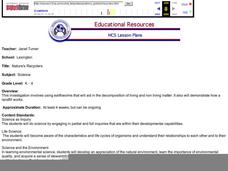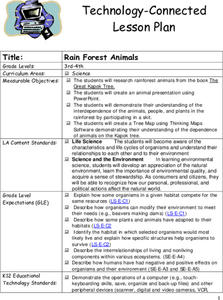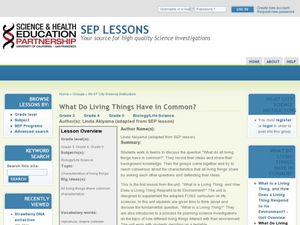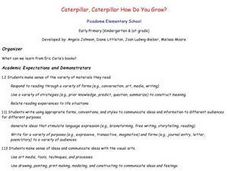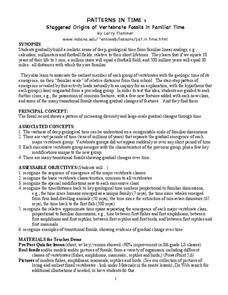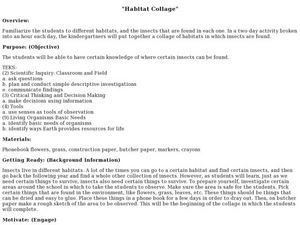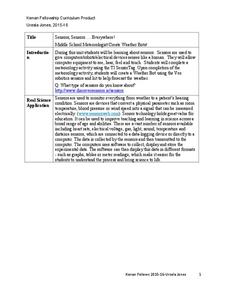Curated OER
Electricity--More Power to Ya!
Fourth graders use research tools to access and synthesize information. They gather and manipulate data using technology. Research and study the components of an electrical circuit. Create a brochure that demonstrates knowledge of how to...
Curated OER
Nature's Recyclers
Students create environments to demonstrate how earthworms interact with their surroundings.
Curated OER
Rain Forest Animals
Students research rainforest animals from the book The Great Kapok Tree. They create an animal presentation using PowerPoint. Pupils demonstrate their comprehension of the interdependence of the animals, people, and plants in the...
Curated OER
Sounds of the Wetlands
Students identify the sounds of different bird calls. In this biology lesson, students create a sound map. They explain how this method is important in tracking wildlife.
Curated OER
What Do Living Things Have In Common?
Students explore the concept of classification. In this classification lesson, students collaborate to create lists of living thing similarities in order to differentiate between living and non-living things. Students create a list of...
Curated OER
Caterpillar, Caterpillar How Do You Grow?
Students work in small groups of three or four to create books based on the Eric Carle books studied. Topics may include tadpoles, guppies, people, moths, and plants. Media used may include Kid Pix, sound recordings, art pieces,...
Curated OER
Give a Hoot - Don't Pollute at Black Bayou Lake
Fourth graders visit Black Bayou Lake refuge to observe the effects of land and water pollution. They photograph examples of pollution. They list the effects of land and water pollution. They write a persuasive letter to convince others...
Curated OER
The Miracle Fish: Learning to Design an Experiment
Students develop procedures to explore the behavior of fish. In this scientific experiment lesson students from a hypothesis, write a question, identify different variables and controls in their experiment.
Curated OER
Biomes and Regions of the United States
Pupils examine and identify the characteristics of the biomes of the world. Using the Internet, they compare and contrast the similarities and differences and discover how living things are supported in the biomes. They discuss how the...
Curated OER
Biomedical Imaging
Students use guided questions and research to compare two biomedical imaging methods. they effectively present their findings to the class. Students use new technical knowledge to summarize and compare new techniques with those they...
Curated OER
Waste Minimization and Protecting the Environment
Pupils study the amount of waste produced and its effects on the environment. They discuss food, money, and energy and how their waste effects others. They read a play to explore how waste is produced and create a collage of materials...
Curated OER
"Fall"owing Changes in the Season
Students create a whole class A-B-"C"eason Book. Each student is responsible for creating a "letter" page relating to changes, adaptations, or other fall concepts. After hard copies of the class ABC books are created, the teachers using...
Curated OER
Patterns In Time
Seventh graders examine fossils. In this vertebrate fossils instructional activity students view a demonstration.
Curated OER
Natural Figures
First graders look for geometrical shapes in nature to help them appreciate the diversity of the natural environment.
Curated OER
Design Project: Simple component curve-tracer circuit
In this circuit activity students complete a series of short answer questions on using a tracer circuit. There are answers with this activity.
Curated OER
Insects
Students, through books, videos, and readings, explore characteristics of insects. In groups, they choose an insect to research. Students discover their insect's diet, how they move, and where they live. Afterwards, they use the facts...
Curated OER
Hey, Look Me Over!
Students make observations about mealworms using hand lenses, rulers, and cotton swabs. Students complete their own mealworm observation chart, then they share their observations with the class. This is one station out of five in an...
Curated OER
Charting the Moon
Sixth graders observe changes in the moon's appearance over a month and keep records of their observations. They write a plan for recording what they see, and a paragraph reflecting on what they have learned over the course of the month.
Curated OER
Is It Hot in the Light?
Third graders make observations about the temperature of items in direct sunlight. In groups, they discuss why asphalt, brick and cement are warmer than items surrounding them. To end the lesson, they examine how heat transfers energy...
Curated OER
Information Reports
Students practice essay skills. In this essay skills lesson, students select an essay subject and take notes for their topic. Students create a web for their essays. Students organize, write, revise, and publish their essays.
Curated OER
Sentence Completion 9 Low-Advanced SAT Level
The explanations sheet is the key to a instructional activity that asks learners to choose the best words to complete sentences. The answer and explanations pages not only identify the correct response but offer an extensive explanation...
Orange County Water Atlas
Location, Location, Location…
Young geographers discover not only how to read and recognize coordinates on a map, but also gain a deeper understanding of latitude and longitude and how climate changes can vary significantly across latitudes.
Kenan Fellows
Sensors, Sensors…..Everywhere! Middle School Meteorologist Create Weather Bots!
My forecast is that you'll want to use the resource. Pupils design and create a weather bot as part of a project-based unit. These bots should be able to measure temperature, humidity, barometric pressure, wind speed and direction, and...

